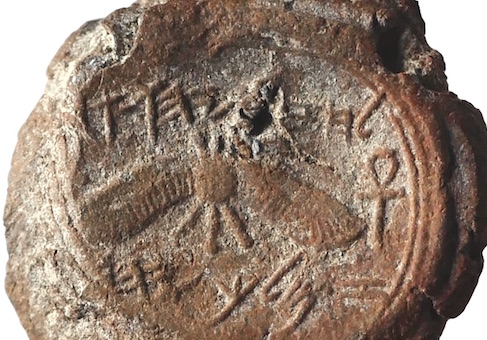Excavators near the Temple Mount in Jerusalem recently made the unprecedented discovery of a royal seal from the time of the First Temple, the Hebrew University of Jerusalem announced Wednesday.
The impression of a royal seal of King Hezekiah dating back 2,700 years was discovered in the Ophel excavations at the base of the Temple Mount’s southern wall. The archaeological project was undertaken by the university’s Institute of Archaeology and is directed by Eilat Mazar, an archaeologist at the university.
In the wake of the latest discovery, Reuven Rivlin, the President of Israel, visited the City of David to view the seal.
The finding comes about a month after archaeologists discovered the remains of the Acra, a Greek fortress central to the story of Hanukkah, in an excavation of the ancient City of David in the Jerusalem Walls National Park.
The impression of the seal, from the time of the First Temple, was imprinted on a bulla, or a piece of inscribed clay, that is believed to have been used to to seal a document. It was inscribed with a phrase written in ancient Hebrew script that reads, "Belonging to Hezekiah [son of] Ahaz king of Judah."
Hezekiah is featured extensively in the Bible and is a direct descendant of King David.
The bulla also bore the impression of a two-winged sun flanked by two ankh symbols meaning life. It was harvested along with pottery shards, figurines, and several other bullae imprinted with seals in the excavations taking place inside the Ophel Archaeological Park in 2009.
Mazar noted the groundbreaking finding in a statement carried by a news release from the university.
"Although seal impressions bearing King Hezekiah’s name have already been known from the antiquities market since the middle of the 1990s, some with a winged scarab (dung beetle) symbol and others with a winged sun, this is the first time that a seal impression of an Israelite or Judean king has ever come to light in a scientific archaeological excavation," Mazar stated.
The university pointed to the "impressive character" of King Hezekiah in the press release announcing the discovery.
"The impressive character and deeds of King Hezekiah are described in the Bible (II Kings, Isaiah, II Chronicles) and in the chronicles of the Assyrian kings--Sargon II and his son Sennacherib--who ruled during his time," the university wrote.
"Hezekiah is depicted as both a resourceful and daring king, who centralized power in his hands. Despite the fact that he was an Assyrian vassal, he successfully maintained the independent standing of the Judean Kingdom and its capital Jerusalem, which he enhanced economically, religiously, and diplomatically."
